Affiliate links on Android Authority may earn us a commission. Learn more.
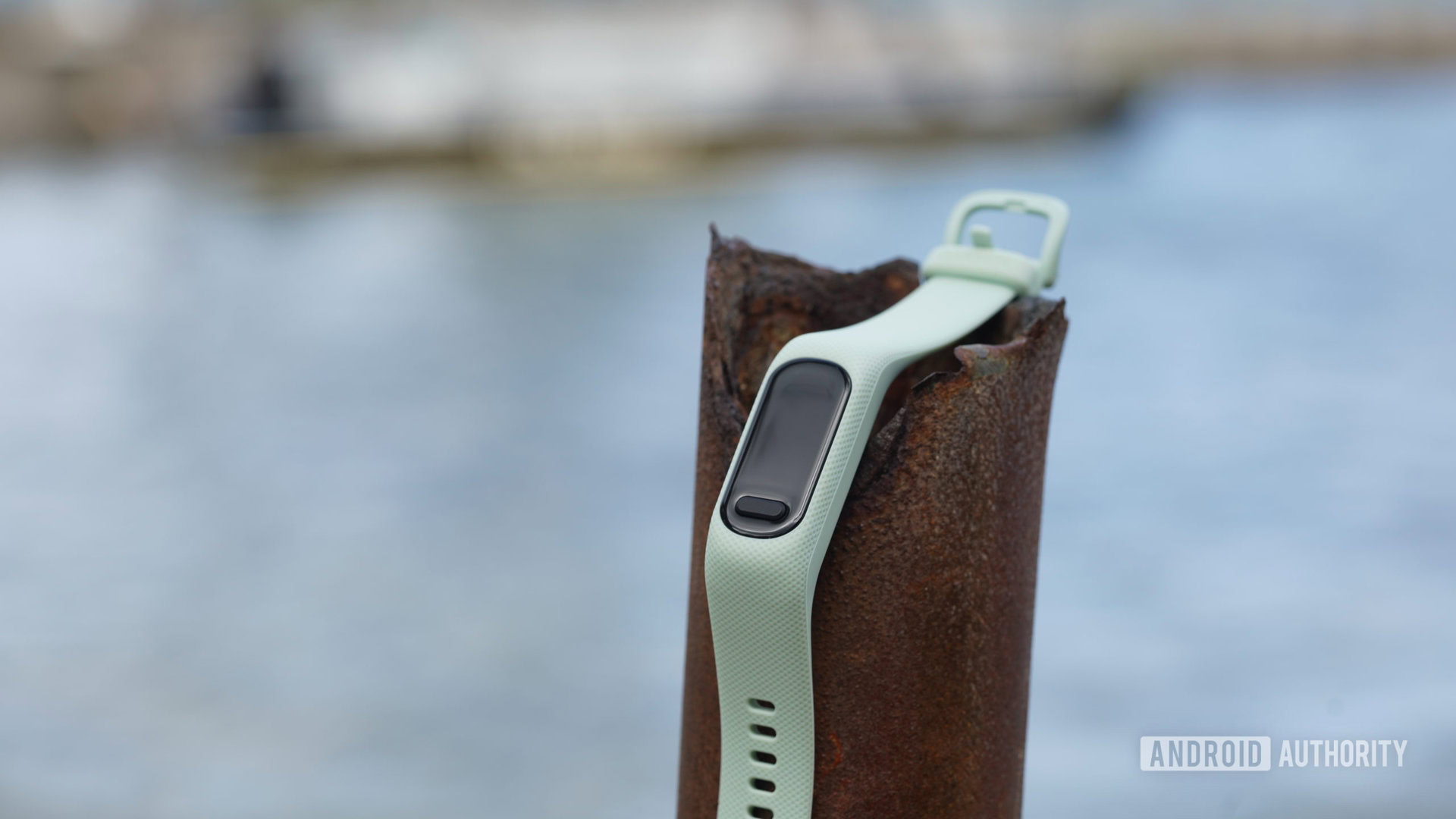
Vivosmart 5 review: Good, but not enough big strides
Published onMarch 17, 2023
Garmin Vivosmart 5
MSRP:
What we like
What we don't like
Garmin Vivosmart 5
It’s been roughly four years since Garmin added a new device to the vivosmart line. But is the fitness tracker everything we hoped for, and more importantly, is it worth the buy? Read our full review of the Garmin vivosmart 5 to find out what the device offers, if it’s among Garmin’s best, and whether you should pick one up.

Update, March 2023: We’ve updated this Garmin vivosmart 5 review with updated pricing and new competition from other fitness tracker players.
What you need to know about the Garmin vivosmart 5

- Garmin vivosmart 5: $149.99 / £129.99 / €149.99
The Garmin vivosmart 5 launched on April 20, 2022, re-entering Garmin in the fitness tracker arena for the first time in a long time. At first glance, the device looks like a beefed-up remodel of the previous generation. It boasts a substantially roomier display, (66% larger according to Garmin), providing more data and menus on screen at a time. It also adds a tangible button to its touchscreen capabilities for easier navigation and equips new swappable bands.
A deeper look shows new activity profiles, added health and safety features, and a few Garmin-specific tools users will recognize from the brand’s existing wearables. These familiar offerings include overnight Pulse Ox monitoring, sleep scores, Body Battery, 24-hour heart rate, women’s health tracking, and more. It can also be synced with Google Fit and Strava via Garmin Connect.
The vivosmart 5 is available in three colors — black, white, and cool mint — for $149.99. This is a little pricey, but what Garmin leans into is the no-subscription-necessary element of its wearables. Unlike competitors like Fitbit, all the band’s highlights are enveloped in its shelf price. No shelling out more later for extra tools or features.
What’s good?
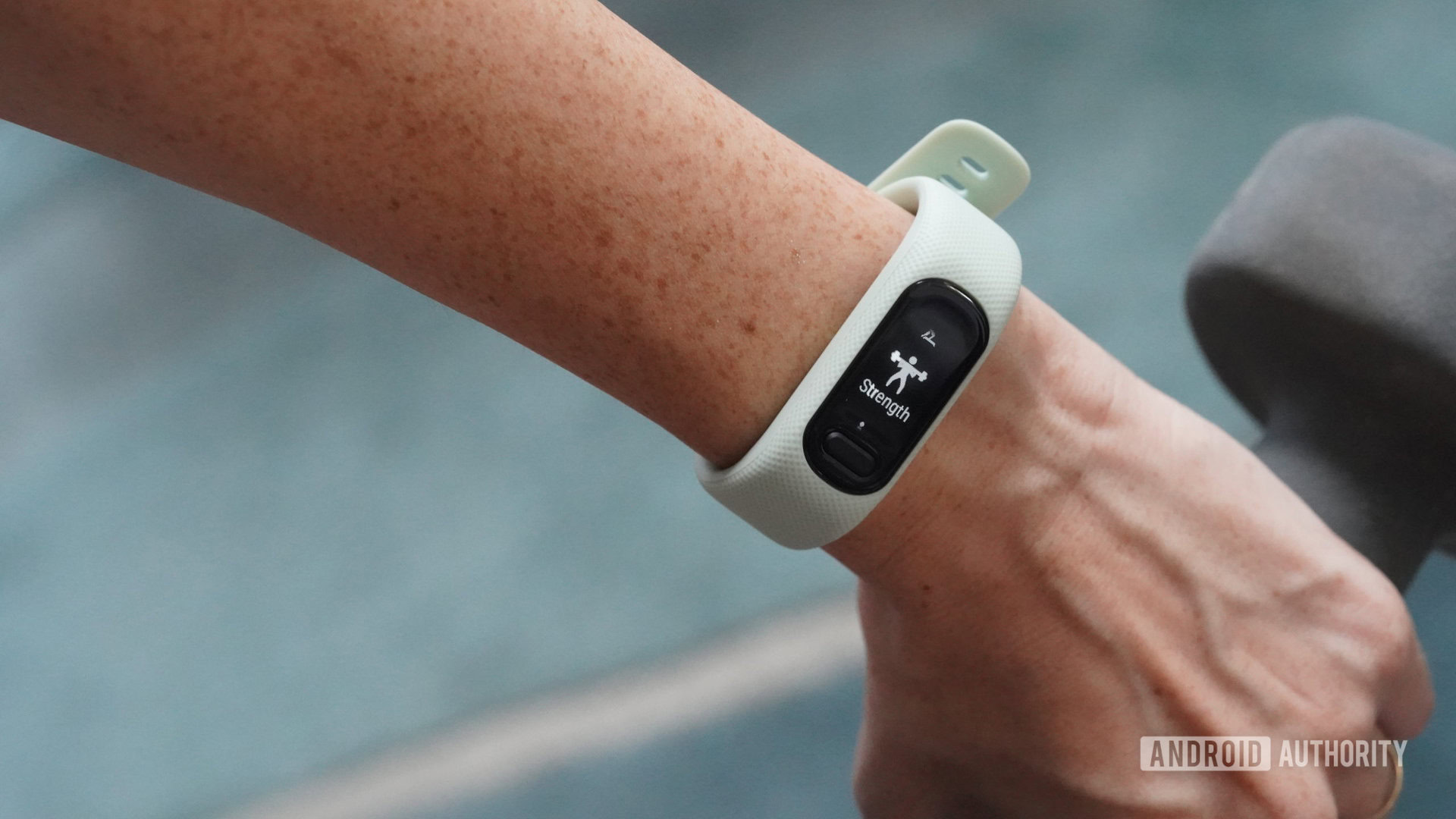
To start, the vivosmart 5 still does all the basics and does them well. It tracks users’ steps, distance, and calories, as well as stress, sleep, heart rate, blood oxygen levels, respiration, and activity. I’ll dig into some of these features further in this vivosmart 5 review, but at face value, this is a good basic fitness tracker from a reliable company.
From a design standpoint, the vivosmart 5 nails comfort. New, swappable bands are a welcome improvement that makes for a more versatile device compared to the unattachable design of the vivosmart 4. The bands are a bit larger than those of the last generation, though it’s a proportionate increase considering this model’s larger display. They’re still lightweight and soft on your skin and the overall impression is far from bulky. Plus, I got mine particularly muddy attempting landscaping chores and it cleaned right up with warm water.
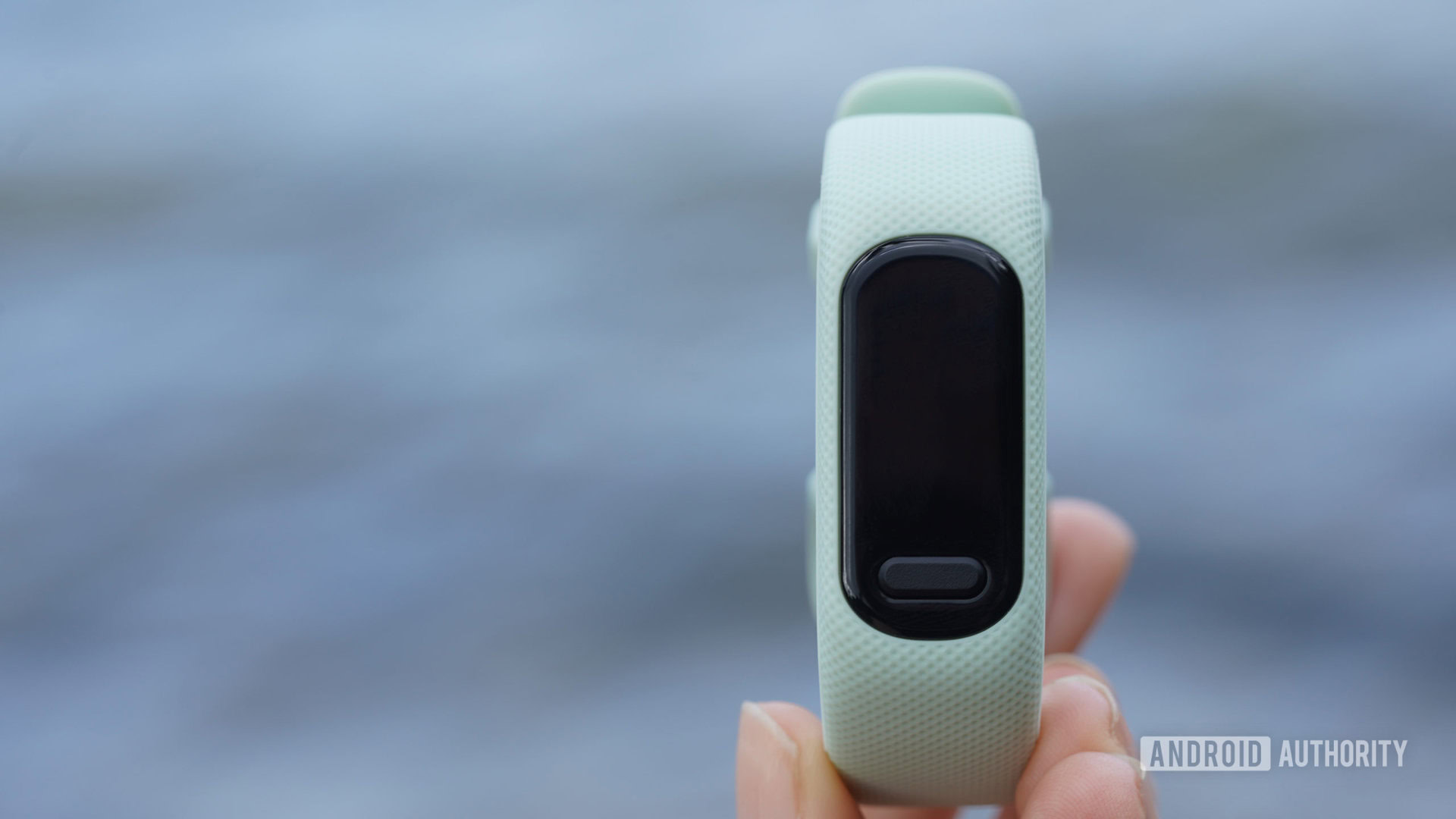
The vivosmart 5 comes in two sizes so a snug fit is easy to find. I’m quite partial to the soft, minty green Garmin provided me for this review but the device is available in black or white as well. For even more options, users can shop third-party bands on Amazon. It’s very easy to pop the tracker itself in and out of the stretchy band, (no need for any tool beyond your own digits).
The vivosmart 5 brings the basics to a bigger display screen, plus adds a new button and swappable bands for an even better user experience.
In addition to the larger screen and subsequently larger text field, Garmin also added a button that makes the vivosmart 5 much easier to navigate. Like on the vivosmart 4, users can still swipe left, right, up, or down to skim through menus and data and can tap the screen to make selections. In addition though, now you can also short- or long-press the added button. From the watch face, a short press takes you to your widgets. In other instances, it will take you back to the last screen you were on. It can also be used for actions like ending a workout or returning to the watch face, or to choose a watch face as the device offers a variety of pre-loaded, customizable options.
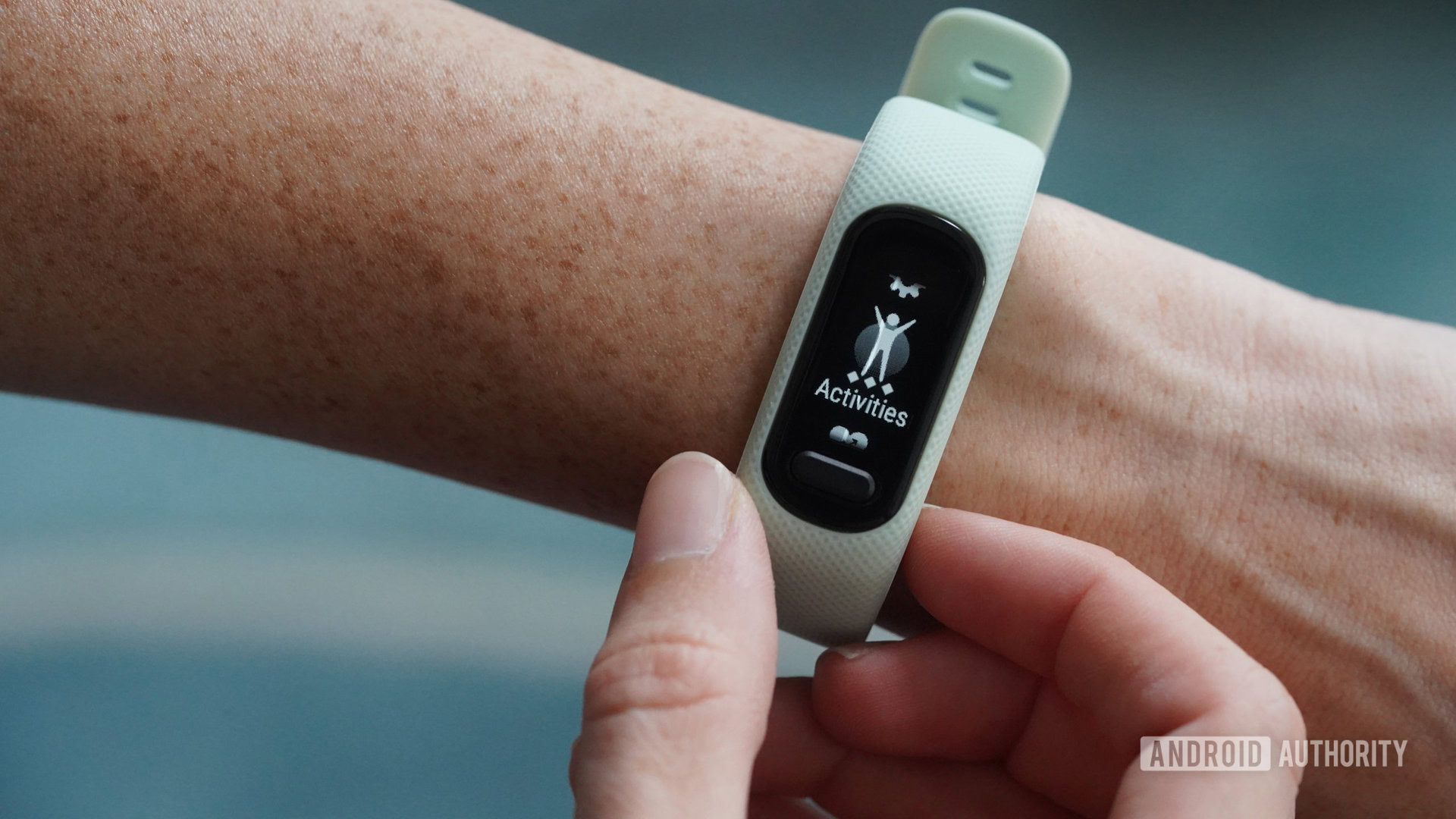
Likewise, the tracker also comes with a number of preloaded widgets that you can add or remove in the Garmin Connect app based on what information you want on hand. The first preloaded widget is of course Activities. I added the Health stats and Health stats 2 widgets, both of which provide summaries of different health stats such as body battery and sleep. On the other hand, I immediately removed the hydration widget because I am a desert plant that consumes a concerningly low amount of drinking water and I don’t want my watch judging me.
As we’ve come to expect from Garmin devices, there is a lot of data to unpack on this device and intuitive navigation comes in handy. For example, if I tap on my steps I can see my daily count as well as my seven-day progress. If I tap on sleep, I can review everything from total hours, to sleep and wake times, to sleep stages, and more.
On the subject of sleep, the vivosmart 5 automatically tracks sleep just like the vivosmart 4, but also now provides an on-wrist sleep score. This comprehensive score is a much easier way to evaluate your sleep at a glance if scrolling through the specifics isn’t for you. I appreciated the addition because sometimes I just want a simple number grade like I’m back in secondary school.
The device also provides a Morning report. When you first wake up, it displays a variety of data points including your sleep score, the weather, calendar events, and your activity goals for the day. You can also tweak what you want to see here in the settings menu.
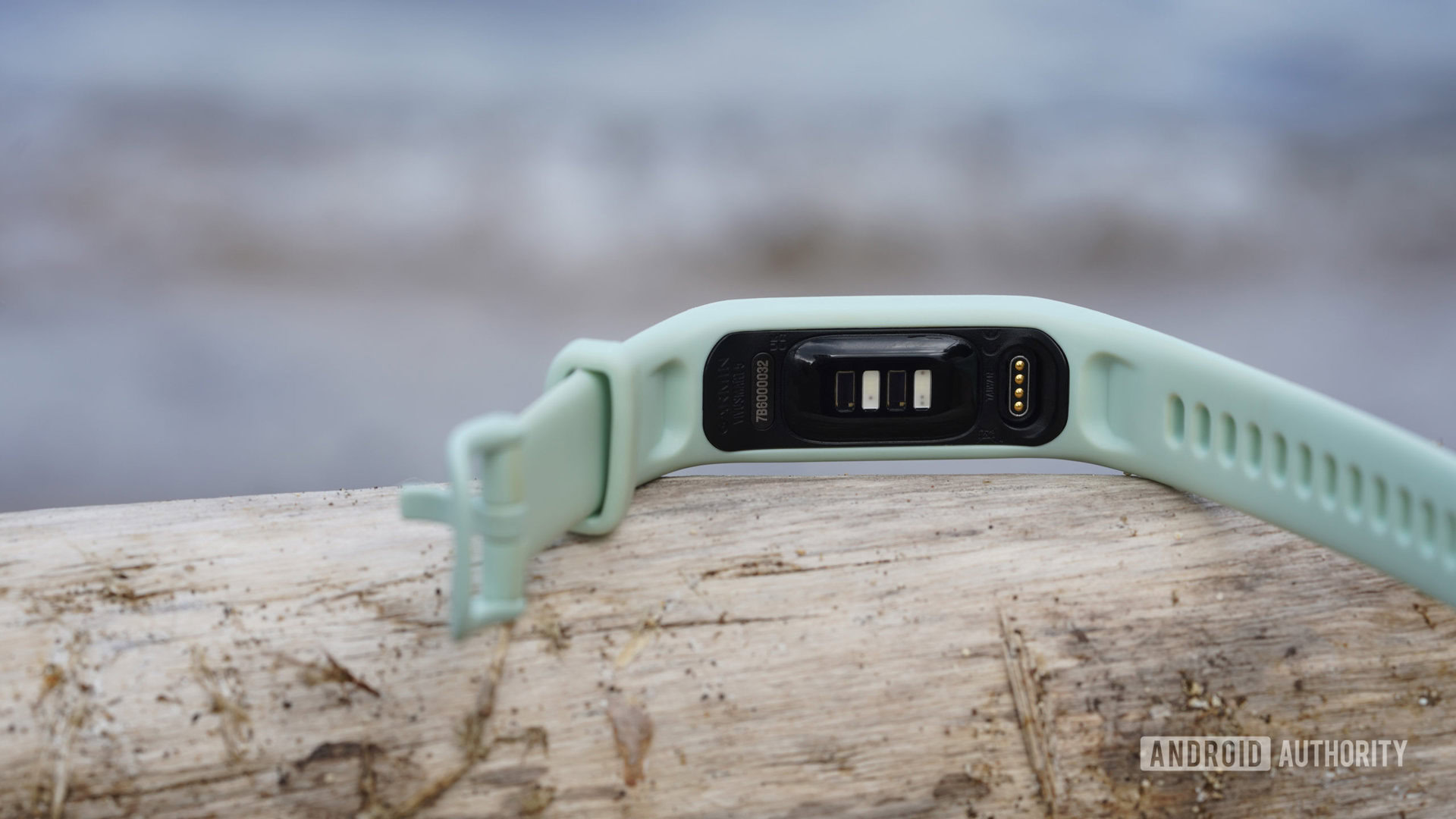
Heart rate accuracy is another high point of this device. The vivosmart 5 offers 24/7 heart rate tracking via Garmin’s Elevate optical HR sensor. Throughout the testing period, I found this sensor to be largely accurate when compared to my Polar HR chest strap as well as the latest Apple Watch. Plus, for athletes who want to broadcast their heart rate to other apps, Garmin added Bluetooth HR broadcasting to the vivosmart 5.
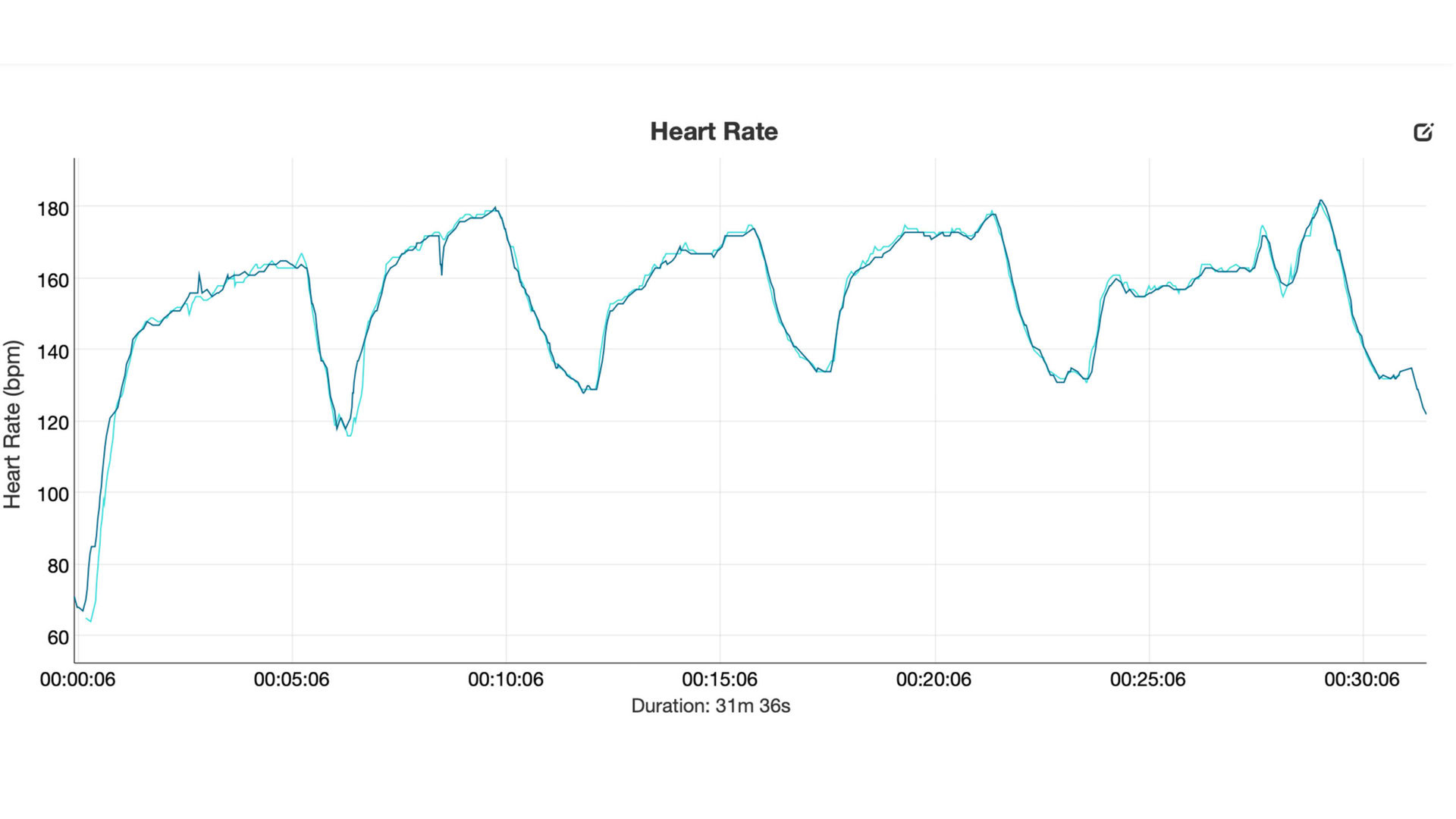
The graph above shows how the device’s heart rate sensor performed when put through its paces on an interval run. Compared to a Polar HR strap, the vivosmart captured accurate peaks and valleys. It kept up with the runner’s heart rate leading up to sprints and coming back down to light jogs.
I also tested the device’s lower impact workouts including yoga, walking, strength training, and breathwork, plus the “other” activity mode for general physical therapy exercises and workouts. Throughout these workouts, the HR sensor performed well.
Users can choose up to 10 activity profiles from the 15 options Garmin makes available on Garmin Connect. Five of the options — breathwork, pilates, interval training, indoor rowing, and treadmill — are new to the vivosmart line. Overall it’s a pretty good haul for an activity tracker with plenty of modes for cross-training purposes.
Finally, Garmin also added respiration rate, LiveTrack, and incident detection to this device. All of these are old-hat for the company, but it is always nice to see these features trickle down to even the most affordable devices in the Garmin stable. Especially safety ones.
What’s not so good?
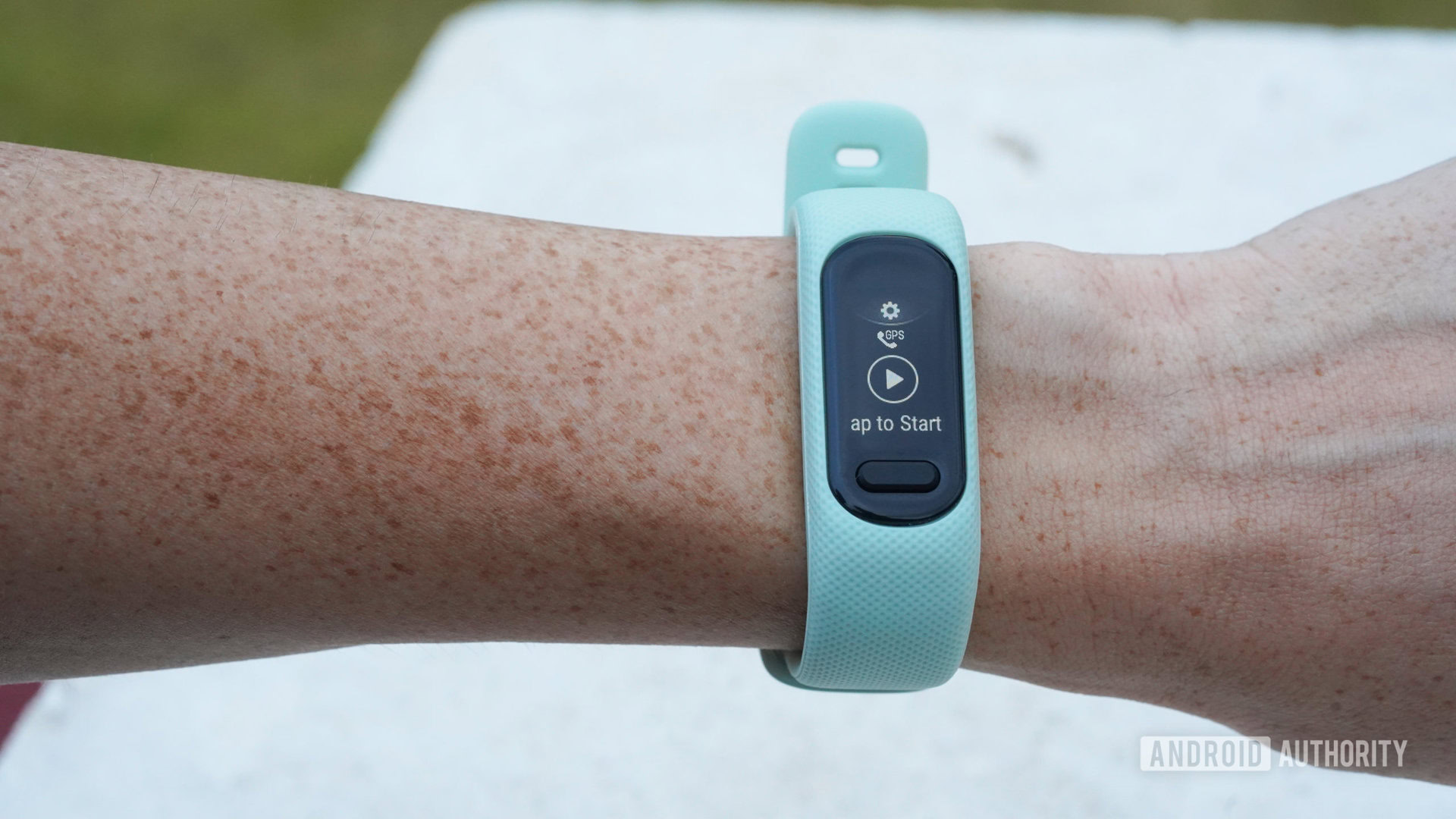
The biggest disappointment users are likely to have is the vivosmart 5’s lack of onboard GPS. Built-in GPS isn’t a given on fitness trackers, though at this price point (and from this brand), we had high hopes. Connected GPS is better than nothing, but it requires you to bring your phone on runs and rides. It also means your data accuracy will only be as good as your phone’s.
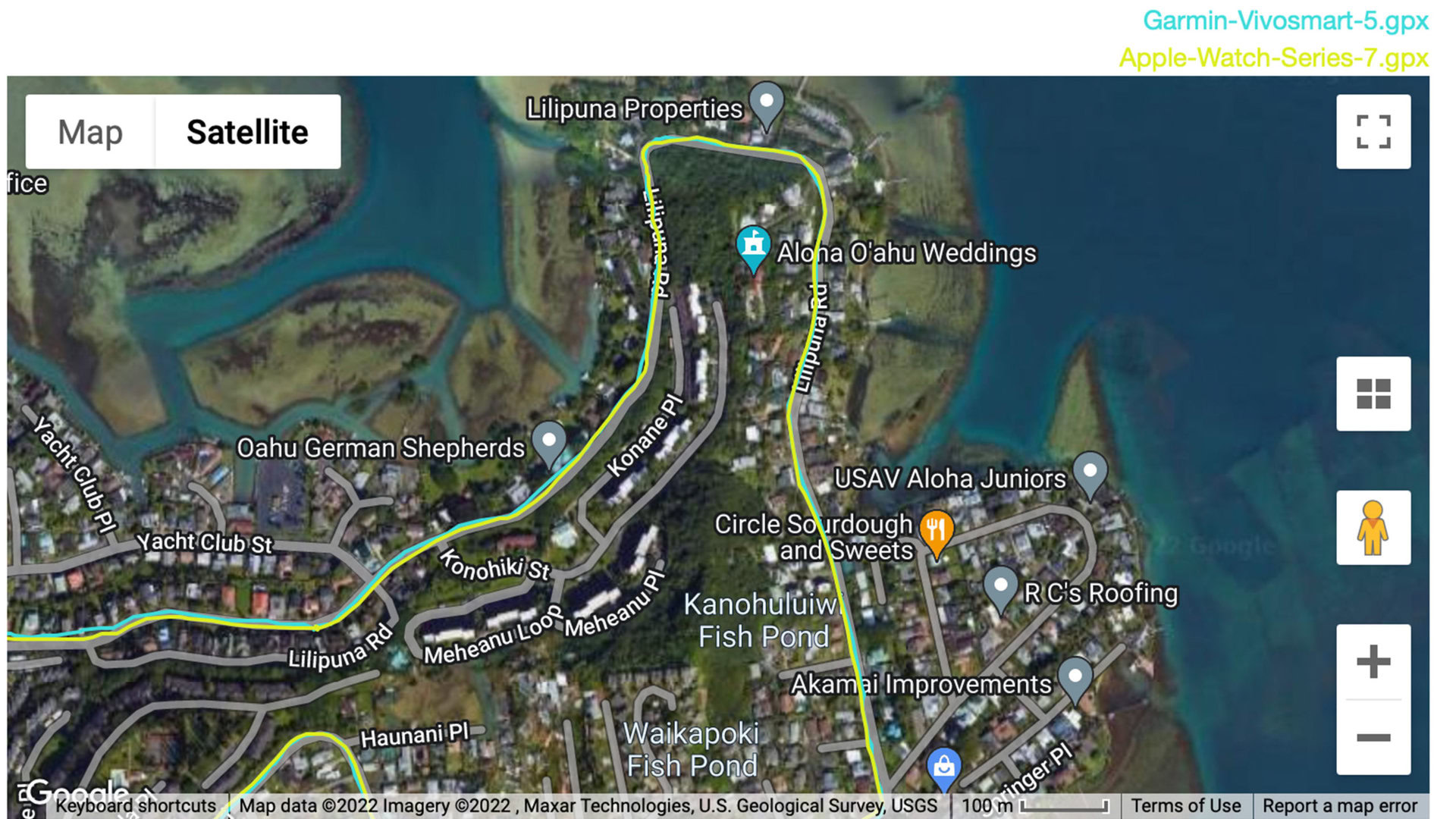
To be fair, the connected GPS worked as well as connected GPS should. The image above shows the GPS data for a three-mile run as measured by the Garmin vivosmart 5 and an Apple Watch Series 7. You can see the Garmin data keeps up well with the Apple Watch and records the runner on the correct side of the road coming around the top turn as well as along the stretch with tree coverage. The final distance was also essentially spot on with the Apple Watch. Again though, the device’s accuracy will depend on that of your paired phone. I didn’t have any issues with pairing or recording data, I just wish it weren’t a necessity.
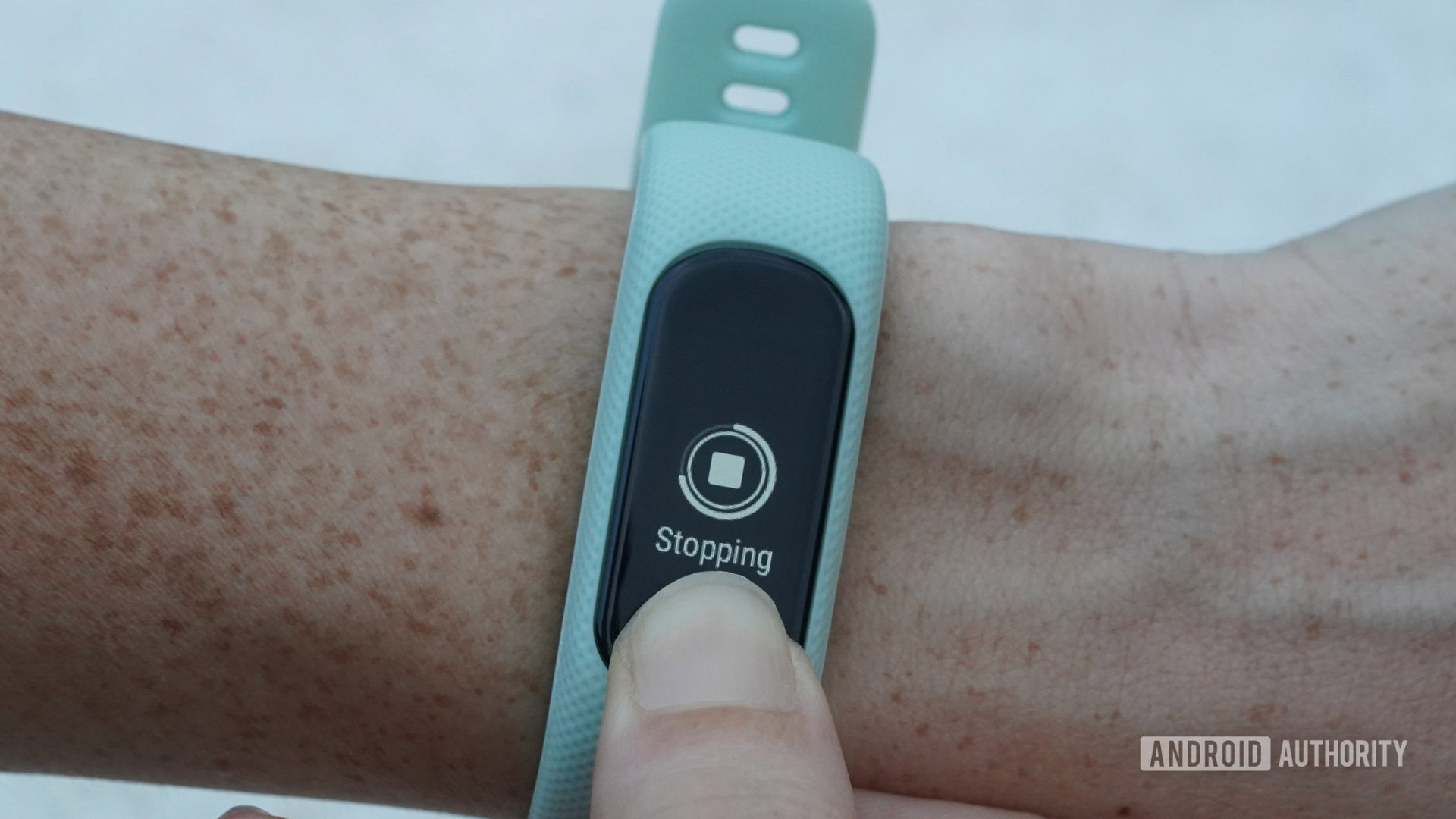
At the end of a workout, stopping your activity takes more effort than I would have expected. You have to hold the device’s physical button down for a few seconds while an on-screen icon fills in. I have to assume this is to keep people from unknowingly stopping a workout with a bump against their device. This isn’t the only fitness tracker that does this, but nonetheless, I found it irksome that a fairly priced tracker might have a better solution. At least you can autodetect walks and runs so long as you turn on the correct setting in the Connect app.
Additionally, the device lives up to Garmin’s week-long usage claim, but I would have liked to see more. Seven-day battery life isn’t terrible, but it isn’t anything to write home about either, especially considering the minimal inputs you can make on the small screen. It’s also the same lifespan we already had on the vivosmart 4. On the other hand, I was very happy to see the vivosmart line ditch its old charger for the streamlined design Garmin now uses on most of its devices. Yay for less e-waste.
The biggest shortcoming of the Garmin vivosmart is the lack of onboard GPS, but it also would have been nice to see improvements to the monochrome display and battery life as well.
What’s not draining the battery life is an always-on display because the device doesn’t offer one. You can customize the screen’s wake time in the settings menu. The options include short, medium, or long, but not always-on.
In general, the display is one of the bigger qualms I have with the design of the Garmin vivosmart 5. In short, I found it to be underwhelming. For starters, it’s monochrome, which is inherently uninspiring, but it’s also especially difficult to read outside. Since mid-outdoor-run is when I like to check stats (and laugh at my elevated heart rate) this was disappointing.
Finally, it was a bummer not to find support for digital payments on this device. Garmin Pay seemed like an easy addition to make this a more well-rounded band for all-day wear. In light of the missing GPS though, I suppose users already need to carry their phones anyway.
Garmin vivosmart 5 specs
| Garmin vivosmart 5 | ||
|---|---|---|
Display | Garmin vivosmart 5 OLED touchscreen 18.5 x 10.5mm 154 x 88 pixels | |
Dimensions and weight | Garmin vivosmart 5 Small/medium: 217 x 19.5 x 10.7mm Fits wrist with circumference of 122-188 24.5g Medium/large: 255 x 19.5 x 10.7mm Fits wrist with circumference of 148-228 26.5g | |
Battery | Garmin vivosmart 5 Up to 7 days in smartwatch mode | |
Sensors | Garmin vivosmart 5 Garmin Elevate heart rate monitor Accelerometer Pulse Ox Ambient light sensor | |
GPS | Garmin vivosmart 5 Connected GPS | |
Water rating | Garmin vivosmart 5 5ATM | |
Compatibility | Garmin vivosmart 5 iPhone, Android | |
Smartwatch features | Garmin vivosmart 5 Smart notifications Text response/reject phone call with text (Android only) Find my Phone | |
Colors | Garmin vivosmart 5 Black White Mint Green |
Garmin vivosmart 5 review: Should I buy it?
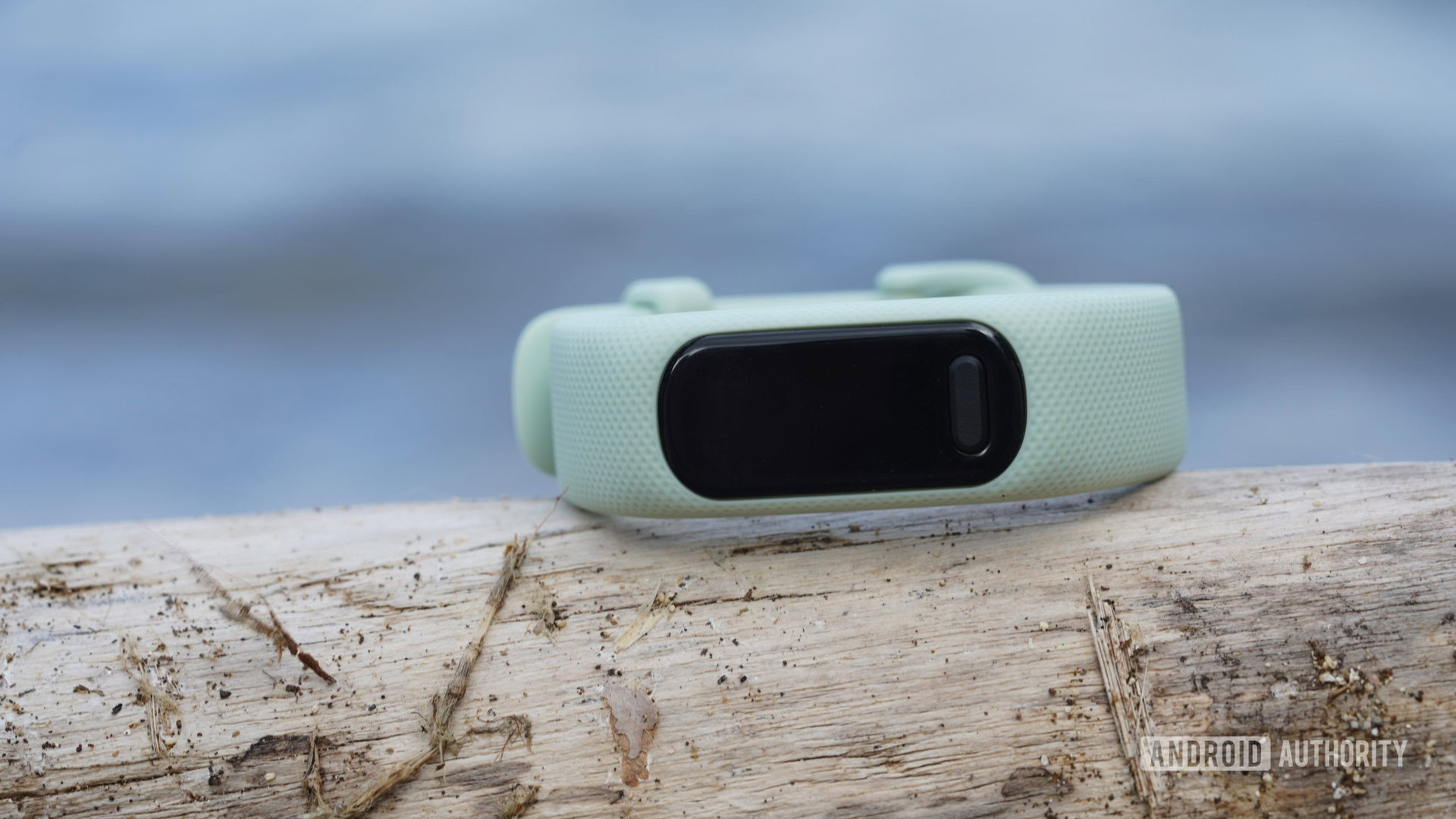
One issue with consistently pumping out high-quality products is you set your own bar awfully high. After knockout launches like the Venu 2 Plus, Fenix 7, and Instinct 2, it’s hard not to hold Garmin to an unfair standard. In general, this is a good tracker, and if athletics are your focus, a very solid option. It’s just not everything we dreamed for the line, and it’s a bit expensive and basic considering its shortcomings.
We were hoping for more with the Garmin vivosmart 5, but that doesn't mean this isn't a solid device for basic fitness tracking.
After such a long wait, we hoped to see the line make bigger strides, particularly in terms of GPS. On the other hand, a simple refresh probably made the most sense for Garmin. Fitness trackers aren’t really the brand’s bread and butter. As the separation continues to shrink between fitness trackers and smartwatches, the niche tracker market will likely continue to see half measures and accommodations.
If you can live with connected GPS or you’re already invested in the Garmin ecosystem, the vivosmart 5 is worth a look. Garmin is the data-rich pick for athletes who want to dive headlong into their numbers. If you are open to shopping around, you may want to consider the Fitbit Charge 5 ($134 at Amazon). It offers a bright, full-color AMOLED display, an ECG scanner, and NFC support for Fitbit Pay. It’s now available at $30 below MSRP at the same price as the vivosmart 5, making it a clear winner between the two.
Both devices have their strengths and weakness so it’s up to shoppers to determine their own priorities. As mentioned earlier though, Garmin doesn’t require a subscription to access the device’s premium features.
Those weighing up Fitbit and Garmin‘s ecosystems but would prefer a larger form factor should consider the Fitbit Versa 3 ($158 at Amazon), which combines the best of a dedicated fitness tracker with the best of a basic smartwatch. It’s now also available for well below MSRP.
iPhone users may consider the new Apple Watch SE (2022) ($269.99 at Amazon). You’ll get plenty of seamless cross-device features between Apple’s products, but you will forego a few fitness basics, like blood oxygen monitoring. It’s also worth considering the advantages of the Apple and Garmin platforms before deciding on a device.
Want to spend a little less? The Xiaomi Mi Band 7 ($46 at Amazon) adds a roomier display, a bigger battery, and more training features to Xiaomi’s venerable series. Fitbit’s newer Inspire 3 ($99.95 at Amazon) also includes all the features a basic tracker should have including a stylish design and a bright AMOLED screen.

Top Garmin vivosmart 5 questions and answers
The Garmin vivosmart 5 does not have onboard GPS, but it can track your location through connected GPS via your phone.
Yes, unlike the vivosmart 4, you can change the band on the vivosmart 5.
The vivosmart 5 has a 5ATM water resistance rating, meaning it can last for short amounts of time submerged in water, like swimming in a pool.
The vivosmart 5 doesn’t offer a ton in the way of smartwatch features. Users can view text messages and other notifications, as well as calendar events. There is however no digital payment support or music controls.
Like Garmin’s more expensive wearables, the vivosmart can automatically send designated family members a LiveTrack link anytime you go for a GPS workout. It will also alert your contacts if it detects a fall or crash.
Yes, you can transfer your workout data from the vivosmart 5 to the popular running and cycling app Strava. You can also sync data with Google Fit via Garmin Connect.
If an altimeter is on your must-haves list you’re out of luck. The vivosmart 5 doesn’t feature the barometric altimeter found on the vivosmart 4.
Much of the data your vivosmart 5 collects can be viewed right on the device’s screen. You can also comb through your stats in the Garmin Connect app.